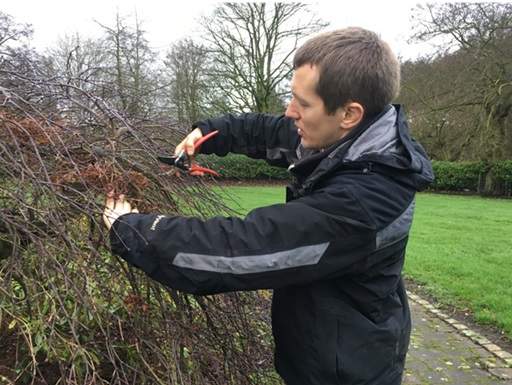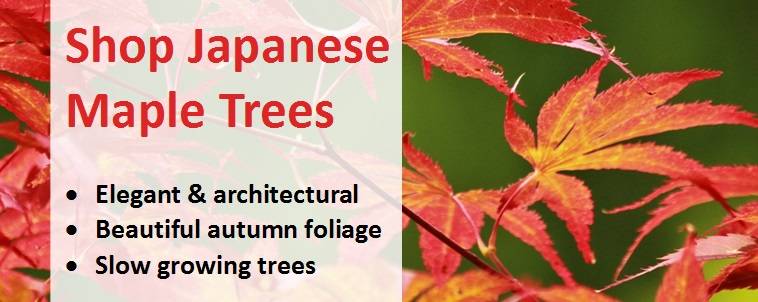How to prune Japanese Maple trees
Prune Japanese maples (Acer palmatum and Acer japonicum) after leaf fall but before January. Some simple pruning can restore or enhance their natural beauty, bringing out the best of these garden favourites for summer and winter viewing. A minimalist approach works best - much of our advice below is about what to avoid doing, as much as how to prune your tree. Japanese maple is often referred to as "shell" pruning because, when done correctly, the top layer of branches form a protective veil of foliage with a shell-like appearance.

Pruning out crossing branches of Acer palmatum dissectum
Types of Japanese Maple tree:
The two most common forms of Japanese maple are:
- Acer palmatum - an upright, understory tree
- Acer palmatum dissectum (and cultivars) - a smaller tree with a weeping habit
When to prune:
- Choosing the right time to prune is key - Japanese maples will bleed sap if pruning is done any later than the end of December.
- Pruning in winter after the leaves have fallen also makes it easier to assess the framework of branches and gauge the best places to cut.
Using the right equipment:
- Secateurs are all you'll need for young Japanese Maple trees. If your tree has branches thicker than our middle finger a pruning saw may come in useful (or keyhole saw for extra precision).
- Sharpen your tools if needed before you start to prune - blunt tools are more likely to snap branches, letting in pests and diseases that will harm your tree.
A few quick warning of what not to do:
- Young Japanese maples may initially develop whippy side branches. Do not remove these. If you're impatient and chop them off you'll only make the problem worse as shortening of pruning away whippy branches only stimulates more of the same. As branches mature they'll widen, forming the robust architectural framework you're looking for.
- Our best advice is to leave your tree unpruned for as long as possible - removing only dead, damaged, badly-placed or crossing branches to encourage a good framework to form.
- Never remove more than 20% of the crown of a Japanese Maple tree - this will not only put the plant under stress but also stimulate unsightly growth.
- Do not remove more than one-quarter of the foliage from any branch, for the same reason.
- Do not cut any branches which are more than half the diameter of the main stem.
- Do not try to restrict the height of your tree. Instead, choose one with a maximum height and spread suitable for your location. Height can rarely be controlled without damaging your tree.
Top Tip: When pruning Japanese Maples, cut outside the 'collar' leaving just one-quarter of an inch (0.5cm) as cuts made too close to the stem may not heal and larger stumps may decay and harbour pests/diseases.
For Upright Japanese Maple Trees:
1) Remove dead, diseased and damaged branches
- Remove any dead or dying branches with discoloured or flaking bark with a clean cut.
- Go slowly to prevent inadvertently slicing into an adjacent branch.
2) Remove lower limbs
- Lower lateral branches that crowd into nearby shrubs or excessively overhang footpaths can be pruned away.
For Mature Trees only:
3) Separate layers
- As your tree becomes more established, you may wish to encourage the development of layers to create the stereotypical form of a mature Japanese maple tree.
- To create this appearance, remove any branches that stray into the layer above or below.
- Check your tree over very carefully before commencing layer pruning, including getting under it and looking up, which will help you identify what you may want to prune.
4) Thin evenly and carefully
- To reduce congestion, move through your tree removing some small lateral branches.
- Successful thinning out will leave every space filled with foliage but with fewer branches.
Top Tip: Don't rush, and when in doubt, don't cut.
For Weeping 'Laceleaf' Japanese Maple Trees:
1) Remove dead, diseased and damaged branches
- Remove any dead or dying branches with discoloured or flaking bark with a clean cut.
- Go slowly to prevent inadvertently slicing into an adjacent branch.
- Weeping varieties can have thin, brittle bark - you may wish to use a keyhole saw to make more precise cuts.
2) Remove dragging branches
- For aesthetic reasons, it's best to prune away any branches which touch the ground or excessively overhang footpaths.
3) Prune unsightly branches
- Chunky limbs which do not taper or branch out along their length can be less attractive. If these ruin the shape of your tree you may wish to remove them.
- Avoid removing any branch that is more than half the diameter of the main stem.
For Mature Trees only:
4) Separate layers
- As your tree becomes more established, you may wish to encourage the development of layers to create the stereotypical form of a mature Japanese maple tree. Note this may not be possible with dwarf weeping varieties; you may wish to check the eventual height and spread of your tree or contact us for advice if in doubt.
- To create this appearance, remove any branches that stray into the layer above or below.
- Avoid removing branches if doing so would leave a large hole, eliminate too much of the tree's canopy or leave a large wound.
5) Thin evenly and carefully
- Remove some small lateral branches to reduce bulk and clutter, being careful never to remove more than 20% of the crown at a time which would put undue stress on your tree.
- Stand back from your tree to check how the shape and structure is changing every few cuts.
- A minimalist approach works best - do not cut any branches more than half the diameter of the main stem and avoid removing more than one-quarter of foliage from any branch.
- Successful thinning out will leave every space filled with foliage but with fewer branches.
6) Create a veiled top layer
- Finally, create a beaded-curtain effect allowing you to see through tiny spaces in the foliage.
- This can be achieved by thinning out many small branches so a layer of twings rises above the main branches like a veil.
- Be careful not to overdo it - stripping out or exposing the topmost main branches could cause sunscald and put your tree at risk of decay.
To control spread:
- If you need to control the spread of your Japanese maple, follow long branches back to a side branch and prune them out at that point. This should not be required on prostrate (low growing/spreading) trees which are best suited to spread naturally to create optimum effect.
Comments
Share this page:


